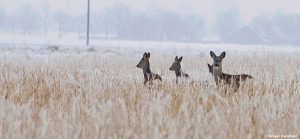| Project duration: | 2014-2020 |
|---|---|
| Project status: | Active |
| Project leader: | prof. dr hab. Bogumiła Jędrzejewska |
| Project co-investigators: |
dr Magdalena Niedziałkowska (MRI PAS) dr Tomasz Borowik (MRI PAS) Kamila Plis (MRI PAS) |
Aims of the project:
- Determining the genetic structure of European roe deer Capreolus capreolus occurring in the northern and central-eastern Europe
- Recognizing the genetic pattern and phylogeography of the species
- Determining the areas which could have served as the eastern refugia during the Last Glacial Maximum
- Reconstructing the postglacial expansion routes of the central mtDNA lineage of roe deer, and other, not recognized until now, mtDNA lineages of roe deer which occur in our study area.
- Determining the level and the range of hybridization between European and Siberian roe deer
- Finding out if hybridization is an effect of the translocations or introgression caused by natural processes.
In this project, we plan to use the following methods:
- Analyses of a fragment of control region of mtDNA (600 bp)
- Analyses of 15 microsatellite loci, previously used in roe deer studies
- Searching for the written sources concerning the history of the studied population including demographic and range fluctuations and translocations conducted by humans.
Research project impact:
The results of the study will allow us to add new data necessary to recognize the whole pattern of phylogenetic and genetic diversity of roe deer in Europe and will help to determine the localization of the eastern LGM refugia of the species. The project will also allow to determine the impact of the translocations of Siberian roe deer conducted in the past on the present genetic diversity of European roe deer and to assess what other factors have an impact on the genetic diversity of European roe deer in the northern and eastern part of its range. The results of this study will provide valuable data which can be used by wildlife managers and nature conservationists. Comparison of genetic data and environmental data will provide information for future models on the impact of climate change on populations of roe deer.
Info for volunteers:
There is no volunteering opportunities at this moment.
Main References:
- Danilkin A (1995) Behavioural Ecology of Siberian and European Roe Deer. Chapman & Hall, London.
- Lorenzini R, Lovari S (2006) Genetic diversity and phylogeography of the European roe deer: the 605 refuge area theory revisited. Biological Journal of the Linnaean Society, 88, 85-100.
- Lorenzini R, Garofalo L, Qin X, Voloshina I, Lovari S (2014) Global phylogeography of the genus Capreolus (Artiodactyla: Cervidae), a Palaearctic meso-mammal. Zoological Journal of the Linnean Society 170: 209-221.
- Matosiuk M, Borkowska A, Świsłocka M, Mirski P, Borowski Z, Krysiuk K, Danilkin AA, Zvychaynaya EY, Saveljev AP, Ratkiewicz M (2014) Unexpected population genetic structure of European roe deer in Poland: an invasion of the mtDNA genome from Siberian roe deer. Molecular Ecology 23, 2559-2572.
- Olano-Marin J, Plis K, Sönnichsen L, Borowik ., Niedziałkowska M, Jędrzejewska B. High genetic diversity but no genetic differentiation between field and forest ecotypes of European roe deer in northeastern Poland. PlosOne 9(10):e109147-e109147
- Randi E, Alves P, Carranza J, Milosevis-Zlatanovic S, Sfougaris A, Mucci N. (2004) Phylogeography of roe deer (Capreolus capreolus) populations: the effects of historical genetic subdivisions and recent nonequilibrium dynamics. Molecular Ecology, 13, 3071-3083.
- Royo L J, Pajares G, Alvarez I, Fernandez I, Goyache F (2007) Genetic variability and differentiation in Spanish roe deer (Capreolus capreolus): A phylogeographic reassessment within the European framework. Molecular Phylogenetics and Evolution, 42, 47-61.
- Sommer RS, Fahlke JM, Schmolcke U, Benecke N, Zachos FE (2009). Quaternary history of the European roe deer Capreolus capreolus. Mammal Review, 39(1), 1-16.
- Svenning JC, Normand S, Kageyama M (2008) Glacial refugia of temperate trees in Europe: insights from species distribution modelling. Journal of Ecology, 96(6), 1117-1127.
